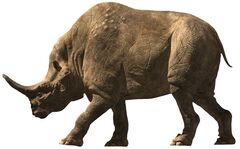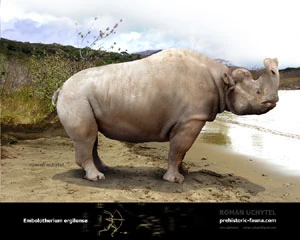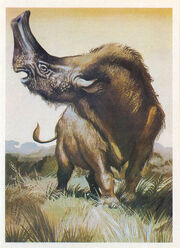(Editing a gallery) |
Tag: Source edit |
||
| Line 36: | Line 36: | ||
==Gallery== |
==Gallery== |
||
| + | |||
| − | <gallery widths="185"> |
||
| − | 7404550.png |
||
| − | Mysterysaurs cryptic cetancodontamorph by wdghk db2m4gn.jpg |
||
| − | Rileys Adventures Embolotherium (1).jpg |
||
| − | Screenshot 2021-01-25 at 9.00.12 AM.png|Only dead individual |
||
| − | Screenshot 2021-01-25 at 9.03.58 AM.png |
||
| − | Screenshot 2021-02-02 at 6.49.06 PM.png |
||
| − | Static-assets-upload16896277698754250009.jpg |
||
| − | Tapir and brontothere collection.png |
||
| − | Tapir and brontothere facts.png |
||
| − | Tapirs and Brontotheres 1.png |
||
| − | </gallery> |
||
[[Category:Herbivores]] |
[[Category:Herbivores]] |
||
[[Category:Eocene mammals]] |
[[Category:Eocene mammals]] |
||
Revision as of 01:03, 29 July 2021
| Embolotherium Temporal range: Late Eocene | |
|---|---|

| |
| Embolotherium andrewsi as it appeared in Walking with Beasts | |
| Scientific classification | |
| Kingdom: | Animalia |
| Phylum: | Chordata |
| Class: | Mammalia |
| Order: | Perissodactyla |
| Family: | †Brontotheriidae |
| Genus: | †Embolotherium |
| Referred species | |
| |
Embolotherium (meaning "battering ram beast", or "wedge beast") is an extinct genus of brontothere that lived in Mongolia during the late Eocene period. It is most easily recognized by a large bony protuberance emanating from the anterior (front) end of the skull. This process resembles a battering ram, thus providing the reason for the name Embolotherium. The animal is known from about 12 skulls, several jaws, and a variety of other skeletal elements from the Ulan Gochu formation of Inner Mongolia and the Irgilin Dzo of Outer Mongolia.
Fossils
Complete skeletons of Embolotherium have not yet been recovered, but if one compares the skulls to other brontotheres, it was probably about 2.5 metres (8.2 feet) tall at the shoulder. Unlike many of the other Late Eocene brontotheres, there is no clear evidence that Embolotherium was sexually dimorphic. All known specimens have large rams. Therefore, coupled with the fact that the rams were hollow and fragile in comparison to the solid and sturdy horns of the North American brontotheres, such as Brontotherium, it does not seem likely that the ram served as a weapon for contests between males. Rather, it might have had a non-sexual function, such as signaling to each other. The ram may have served as a specialized resonator for sound production. This hypothesis is suggested by the fact that the bony nasal cavity extends to the peak of the ram, thus implying that the nasal chamber was greatly elevated, possibly creating a resonating chamber.
Other Relatives
Several species of Embolotherium have been named, including Embolotherium andrewsi, Embolotherium grangeri, Embolotherium louksi, Embolotherium ultimum, Embolotherium ergilensi, and Embolotherium efremovi. However, only two species, Embolotherium andrewsi and Embolotherium grangeri, appear to be valid. Other supposed species of Embolotherium are probably synonymous with these two species and were originally based on juvenile skulls, poorly preserved fossil material, or specimens that are not significantly different from either E. andrewsi or E. grangeri. Another genus of brontothere, Titanodectes, which was named for several lower jaws found in the same sedimentary deposits as Embolotherium, probably represents the same beast as Embolotherium grangeri. Protembolotherium is another closely related genus from the Middle Eocene, which is distinguished by a noticeably smaller ram.

Embolotherium ergilense
Description
Embolotherium was one of the central Asian representatives of the family of large herbivorous mammals known as brontotheres ("thunder beasts"), which were ancient (and distant) cousins of the modern rhinoceros. Of all the brontotheres (which also included Brontotherium), Embolotherium had the most distinctive "horn," which actually looked more like a broad, flat shield sticking up from the end of its snout. As with all such animal accoutrements, this odd structure may have been used for display and/or to produce sounds, and it was doubtless a sexually selected characteristic as well (meaning males with more prominent nose ornaments mated with more females).

An outdated depiction of Embolotherium. Note that the bony horn was thought to be the nasal structure of the beast at that time, and so Embolotherium's head got distorted.
In the Media
- In Ice Age & the Video Game version of Ice Age: Dawn of the Dinosaurs, Carl is a Embolotherium.

Carl is a Embolotherium
- Walking With Prehistoric Beasts- Ep.2 Whale Killer.
- In both Ice Age the Meltdown (Movie & Video Game) & Ice Age: Dawn of the Dinosaurs, there is some young Rhinos that appear to be Embolotherium calves.
- Life After Dinosaurs.
- Primeval.
